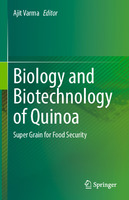| dc.contributor.author | Alandia, Gabriela | es |
| dc.contributor.author | Rodríguez, Juan Pablo | es |
| dc.contributor.author | Palmgren, Michael | es |
| dc.contributor.author | Condori Ali, Bruno | es |
| dc.contributor.author | López-Marqés, Rosa Laura | es |
| dc.contributor.editor | Varma, Ajit | |
| dc.coverage.spatial | Singapore | es |
| dc.date.accessioned | 2022-06-27T18:44:37Z | |
| dc.date.available | 2022-06-27T18:44:37Z | |
| dc.date.issued | 2021 | |
| dc.identifier.uri | https://repositorio.iica.int/handle/11324/20568 | |
| dc.description.abstract | In the last 30 years, quinoa started to be tested and produced in more than 100 countries outside the Andes, its region of origin. Nowadays, quinoa is found in more than 120 countries around the globe. During this time, biotechnology has become an important tool for different areas of research in quinoa, especially with the use of genetic markers. Biotechnology applications in this underutilized grain started in the United States, and their use has been more intensive in countries where quinoa was recently introduced. Biotechnology benefitted the quinoa sector with numerous studies on the species evolution, responses to abiotic stress, and assisted methods for faster genetic improvement. The recent quinoa genome description enables an exponential development with the complementation from novel areas, techniques, and tools such as omics and bioinformatics. Despite this, biotechnology applications in the Andean countries have been more limited due to economic and politic contexts. Nevertheless, biotechnology has been used to characterize the rich Andean germplasm, improve conservation systems, and develop bioinput. In this sense, since biotechnology should keep providing solutions for food security under healthy, sustainable, and reasonable principles, its use can be highly recommended. Biotechnology has the great potential to accelerate conventional breeding processes commonly applied to this crop, as well as to generate alternative options to enhance the production system and as model to improve other crops. With an integrative view and collaboration between different countries, biotechnology can provide tangible benefits to different stakeholders. | es |
| dc.format.extent | 32 páginas | es |
| dc.language.iso | en | es |
| dc.publisher | Springer | es |
| dc.relation.ispartof | Biology and Biotechnology of Quinoa. Super Grain for Food Security | es |
| dc.relation.uri | https://doi.org/10.1007/978-981-16-3832-9 | |
| dc.relation.uri | https://doi.org/10.1007/978-981-16-3832-9_5 | |
| dc.subject | Agricultura||agriculture||agricultura||agriculture | es |
| dc.subject | Biotecnología vegetal||plant biotechnology||Biotecnologia vegetal||biotechnologie végétale | es |
| dc.subject | Biología molecular||molecular biology||Biologia molecular||biologie moléculaire | es |
| dc.subject | Fisiología vegetal||plant physiology||Fisiologia vegetal||physiologie végétale | es |
| dc.subject | Bioquímica||biochemistry||Bioquímica||biochimie | es |
| dc.subject | Biología celular | es |
| dc.subject | Cell biology | es |
| dc.subject | Quinua | |
| dc.subject | quinoa | |
| dc.subject | Producción | |
| dc.subject | production | |
| dc.subject | produção | |
| dc.subject | Transferencia de tecnología | |
| dc.subject | technology transfer | |
| dc.subject | transfert de technologie | |
| dc.subject | transferência de tecnologia | |
| dc.subject.other | Representación Bolivia | es |
| dc.title | Advances of Biotechnology in Quinoa Production: A Global Perspective | es |
| dc.type | Capítulo del libro | es |


